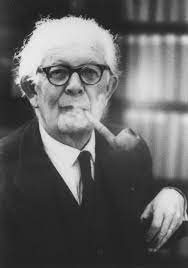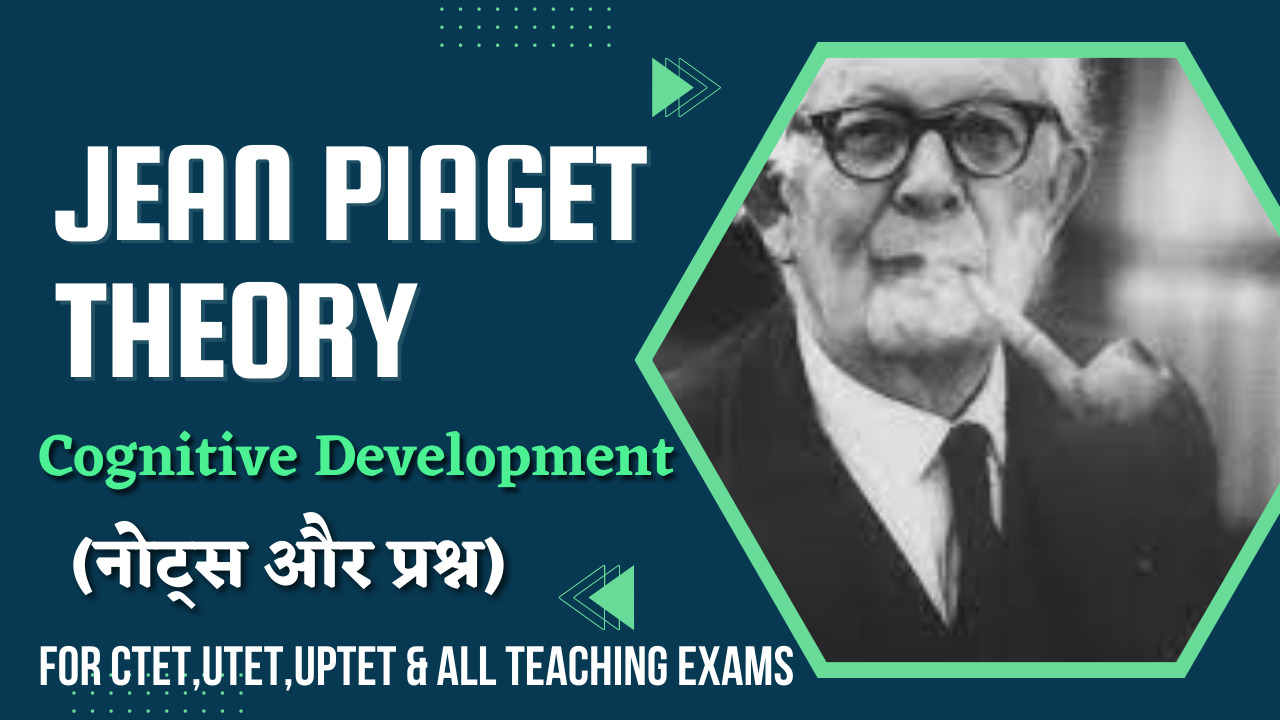Jean Piaget’s theory of cognitive development, which outlines how children actively construct their understanding of the world and progress through four stages of cognitive development. Learn how this theory has practical applications in education and gain insight into the importance of play in cognitive growth. Explore criticisms of Piaget’s theory and how researchers have responded to them.
Jean Piaget was a Swiss psychologist who is known for his theory of cognitive development that has influenced the field of child development and education. Piaget’s theory focuses on how children develop their cognitive abilities and thinking processes as they grow older. In this article, we will explore Piaget’s theory and its relevance for CTET (Central Teacher Eligibility Test) aspirants.

Stages of Jean Piaget’s Theory of Cognitive Development
According to Piaget, cognitive development occurs in four stages: These stages describe the ways in which children learn, think, and perceive the world around them.
- Sensorimotor Stage (0-2 years): Infants in this stage learn through their senses and motor activities. They explore the world around them by touching, grasping, and mouthing objects.
- Preoperational Stage (2-7 years): Children in this stage develop language and symbolic thinking. They use symbols to represent objects and ideas, and can engage in imaginative play.
- Concrete Operational Stage (7-11 years): Children in this stage can think logically about concrete objects and events. They can classify, sort, and order objects based on their attributes.
- Formal Operational Stage (11 years and beyond): In this stage, children develop abstract thinking and can reason logically about hypothetical situations. They can think about ideas and concepts that are not based on concrete objects or events
Jean Piaget’s theory has significant implications for education, as it suggests that children’s thinking processes are not simply miniature versions of adult thinking. Instead, children’s thinking is qualitatively different from adult thinking, and their cognitive development depends on their experiences and interactions with the environment.
Jean Piaget’s Theory Important Terms
Jean Piaget was a Swiss developmental psychologist and cognitive theorist who made significant contributions to the field of child development. Here are some important terms associated with Piaget’s theories:
- Cognitive Development: Piaget’s theory focused on the cognitive development of children, which refers to the development of mental processes such as attention, memory, problem-solving, and reasoning.
- Schemas: Schemas are mental frameworks that we use to organize and interpret information. According to Piaget, we develop and modify our schemas through experiences.
- Assimilation: Assimilation is a process by which individuals or groups from one cultural background adopt and integrate elements of another culture, often resulting in a blending or merging of cultural practices, beliefs, and values. This can occur when people from different cultural backgrounds come into contact and interact with each other over time.
- Accommodation: Accommodation is the process of modifying existing schemas to fit new information. For example, a child may modify their schema for a “dog” when they encounter a cat.
- Equilibration: Equilibration is the process of achieving balance between existing knowledge and new experiences. Piaget believed that this process is what drives cognitive development.
- Stages of Development: Piaget proposed four stages of cognitive development: the sensorimotor stage (0-2 years), the preoperational stage (2-7 years), the concrete operational stage (7-12 years), and the formal operational stage (12+ years).
- Object Permanence: Object permanence is a concept in developmental psychology that refers to a child’s ability to understand that objects continue to exist even when they are not directly observable. In other words, it is the understanding that an object continues to exist even when it is out of sight or no longer in the immediate environment. According to Piaget, this is developed during the sensorimotor stage.
- Conservation: In Jean Piaget’s theory of cognitive development, conservation refers to the understanding that certain properties of objects, such as mass, volume, and number, remain the same despite changes in their physical appearance. Piaget identified conservation as a key concept in the stage of cognitive development called the concrete operational stage, which typically occurs between the ages of 7 and 11.
- Egocentrism: Egocentrism is the tendency to view the world from one’s own perspective and to have difficulty understanding other people’s perspectives. Piaget believed that this is a characteristic of the preoperational stage.
- Zone of Proximal Development: The zone of proximal development is the difference between what a child can do on their own and what they can do with assistance. Piaget believed that learning occurs when children are given tasks that are within their zone of proximal development.
What is the difference between Assimilation and Accommodation?
Sure, here’s a table summarizing the main differences between assimilation and accommodation in Piaget’s theory:
| Assimilation | Accommodation |
|---|---|
| Incorporating new information into existing schemas | Modifying existing schemas to fit new information |
| A process of adding to existing knowledge | A process of changing existing knowledge |
| Occurs when a child encounters new information that fits their existing understanding | Occurs when a child encounters new information that does not fit their existing understanding |
| Does not necessarily lead to significant changes in understanding | Can lead to significant changes in understanding |
| Can help reinforce existing schemas | Can help promote cognitive development |
| Can be a quick and automatic process | Can be a slower and deliberate process |
In summary, assimilation involves incorporating new information into existing knowledge, while accommodation involves modifying existing knowledge to fit new information. Both processes are important for cognitive development, but they have different effects and are used in different situations.
Educational Implication of Piaget’s Cognitive Development Theory
Here’s a table that summarizes some educational implications of Piaget’s theory:
| Stage of Development | Educational Implications |
|---|---|
| Sensorimotor (0-2 years) | – Provide rich sensory and motor experiences. |
| – Use objects and toys that promote exploration. | |
| – Encourage caregivers to interact with infants and respond to their needs. | |
| Preoperational (2-7 years) | – Use concrete materials to help children understand concepts. |
| – Provide opportunities for imaginative play. | |
| – Use real-life situations to teach problem-solving skills. | |
| Concrete Operational | – Use concrete examples to teach abstract concepts. |
| (7-12 years) | – Use hands-on activities to help children understand complex ideas. |
| – Encourage children to explain their reasoning and thought processes. | |
| Formal Operational | – Encourage independent thinking and problem-solving. |
| (12+ years) | – Encourage abstract and hypothetical thinking. |
| – Use discussion and debate to encourage critical thinking. |
This table presents a summary of educational implications for each of Piaget’s stages of cognitive development. For each stage, the table highlights several strategies that educators can use to support children’s cognitive growth and development. These strategies include providing rich sensory and motor experiences during the sensorimotor stage, using concrete examples to teach abstract concepts during the concrete operational stage, and encouraging independent thinking and problem-solving during the formal operational stage.
Important MCQs Related to Jean Piaget Theory for CTET Exam
1. According to Jean Piaget’s theory, what is the term for the mental process of taking in new information and incorporating it into existing knowledge
a. Accommodation
b. Assimilation
c. Equilibration
d. Disequilibrium
Answer: b. Assimilation
2. Which of Piaget’s stages of cognitive development occurs between birth and approximately 2 years of age?
a. Preoperational
b. Concrete operational
c. Formal operational
d. Sensorimotor
Answer: d. Sensorimotor
3. According to Piaget, which type of play is most common during the preoperational stage of development?
a. Parallel play
b. Cooperative play
c. Imaginative play
d. Competitive play
Answer: c. Imaginative play
4. What is the term for the process of adjusting existing knowledge structures in response to new information?
a. Accommodation
b. Assimilation
c. Equilibration
d. Disequilibrium
Answer: a. Accommodation
5. According to Piaget, which stage of cognitive development is characterized by the ability to think abstractly and hypothetically?
a. Preoperational
b. Concrete operational
c. Formal operational
d. Sensorimotor
Answer: c. Formal operational
6. What is the term for the cognitive state of balance or stability between existing knowledge structures and new information?
a. Accommodation
b. Assimilation
c. Equilibration
d. Disequilibrium
Answer: c. Equilibration
7. According to Piaget, what is the primary way that children learn during the sensorimotor stage of development?
a. Through imitation of adults
b. Through exploration and play
c. Through social interaction with peers
d. Through formal instruction from adults
Answer: b. Through exploration and play
8. What is the term for the mental process of resolving inconsistencies between existing knowledge structures and new information?
a. Accommodation
b. Assimilation
c. Equilibration
d. Disequilibrium
Answer: d. Disequilibrium
9. According to Piaget, which stage of cognitive development is characterized by the ability to understand conservation?
a. Preoperational
b. Concrete operational
c. Formal operational
d. Sensorimotor
Answer: b. Concrete operational
10. What is the term for the cognitive state in which existing knowledge structures are unable to accommodate new information?
a. Accommodation
b. Assimilation
c. Equilibration
d. Disequilibrium
Answer: d. Disequilibrium
CDP Ctet Questions in Hindi : CTET 2022 के लिए बाल विकास के ये प्रश्न है बेहद महत्वपूर्ण, जरूर पढ़े
What is the theory of cognitive development proposed by Jean Piaget
Jean Piaget’s theory of cognitive development is a comprehensive framework for understanding how children’s thinking develops over time. According to Piaget, children progress through a series of four distinct stages of cognitive development, each characterized by increasingly complex forms of thinking. These stages are the sensorimotor stage, the preoperational stage, the concrete operational stage, and the formal operational stage.
What are some criticisms of Jean Piaget’s theory of cognitive development, and how have researchers responded to these criticisms?
Some of the criticisms of Jean Piaget’s theory of cognitive development include that his theory focuses too much on individual cognitive development and does not account for cultural and social influences on cognition, that his stages may be too rigid and not account for individual differences, and that his methods of assessment may have limitations.
What are the application of Piaget theory of cognitive development
Curriculum development: Piaget’s theory suggests that children learn best when they are actively engaged in the learning process and are able to construct their own understanding of the world
Instructional strategies: Piaget’s theory also suggests that children’s cognitive abilities develop in a series of stages, and that instruction should be tailored to the specific stage of development of the child.
Assessment: Piaget’s theory provides a framework for understanding how children’s thinking develops over time, and assessment tools can be developed to measure children’s progress through the stages of cognitive development.
Play-based learning: Piaget believed that play is an important component of cognitive development, and many educational programs use play-based learning to encourage children to explore and experiment in a safe, structured environment.
What are the main points of Piaget’s theory?
The main points of Piaget’s theory include the following:
Children actively construct their understanding of the world
Cognitive development occurs in stages:
Assimilation and accommodation
Equilibration
Play is important for cognitive development
How is Piaget’s Theory Different from others?
One of the main differences is that Piaget’s theory emphasizes the active role of the child in constructing their understanding of the world, while other theories focus more on external factors such as social and environmental influences. Additionally, Piaget’s theory identifies distinct stages of cognitive development, while other theories may describe cognitive development as a more gradual process. Finally, Piaget’s theory emphasizes the importance of play in cognitive development, while other theories may not give play as prominent a role. Overall, Piaget’s theory provides a unique perspective on cognitive development that emphasizes the importance of children’s active engagement with their environment and the role of play in supporting cognitive growth.
